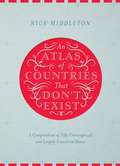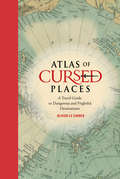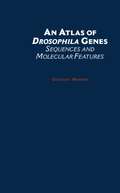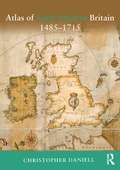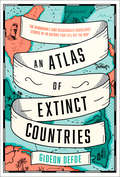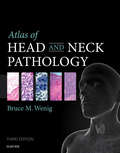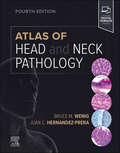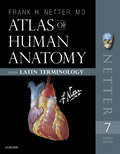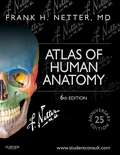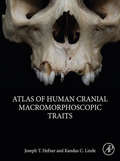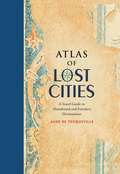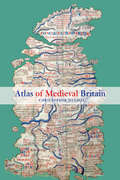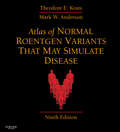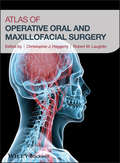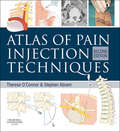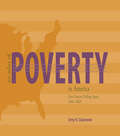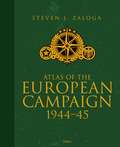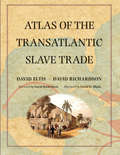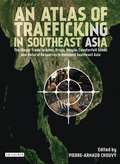- Table View
- List View
An Atlas of Countries That Don't Exist: A Compendium of Fifty Unrecognized and Largely Unnoticed States
by Nick MiddletonAcclaimed travel writer and Oxford geography don Nick Middleton takes us on a magical tour of countries that, lacking diplomatic recognition or UN membership, inhabit a world of shifting borders, visionary leaders and forgotten peoples.Most of us think we know what a country is, but in truth the concept is rather slippery. From Catalonia to the Crimea, and from Africa's last colony to the European republic that enjoyed just a solitary day of independence, the places in this book may lie on the margins of legitimacy, but all can be visited in the real world.Beautifully illustrated by fifty regional maps, each shadowy country is literally cut out of the page of this book. Alongside stories, facts and figures, An Atlas of Countries That Don't Exist brings to life a dreamlike world of nations that exist only in the minds of the people who live there.
Atlas of Cursed Places: A Travel Guide to Dangerous and Frightful Destinations
by Olivier Le CarrerAtlas Obscura says this lushly illustrated New York Times bestselling guide to dozens of dangerous, eerie, and infamous locations is the perfect gift for "those who believe the world is still full of mysteries to investigate."Pick up the acclaimed Atlas of Cursed Places and visit the world's most nerve-wracking locations. With pithy historical profiles, vintage full-color maps, and haunting tales that will color your perspective (and send tingles down your spine), this is a clever gift for the intrepid traveler or armchair adventurer who wants to explore destinations both remarkable and daunting. Visit:a coal town where the ground is constantly on firea Zambian national park where more than 8 million bats darken the skiesthe infamous suicide location of Aokigahara Forest near Mount Fujithe lesser-known Nevada triangle, in which dozens of aircraft have inexplicably disappeared Beautifully packaged and written with a twisty sense of humor, Atlas of Cursed Places puts your quirky side on the map.
Atlas of Cursed Places: A Travel Guide to Dangerous and Frightful Destinations
by Olivier Le CarrerAtlas Obscura says this lushly illustrated New York Times bestselling guide to dozens of dangerous, eerie, and infamous locations is the perfect gift for "those who believe the world is still full of mysteries to investigate." Pick up the acclaimed Atlas of Cursed Places and visit the world's most nerve-wracking locations. With pithy historical profiles, vintage full-color maps, and haunting tales that will color your perspective (and send tingles down your spine), this is a clever gift for the intrepid traveler or armchair adventurer who wants to explore destinations both remarkable and daunting. Visit:a coal town where the ground is constantly on firea Zambian national park where more than 8 million bats darken the skiesthe infamous suicide location of Aokigahara Forest near Mount Fujithe lesser-known Nevada triangle, in which dozens of aircraft have inexplicably disappeared Beautifully packaged and written with a twisty sense of humor, Atlas of Cursed Places puts your quirky side on the map.
An Atlas of Drosophila Genes: Sequences and Molecular Features
by Gustavo MaroniDrosophila, the common fruit fly, is the most extensively studied of all organisms from the standpoint of genetics and cytology. This atlas summarizes what is known about the approximately 100 Drosophila genes for which the complete nucleotide sequence is known. Each entry includes a description of the gene's molecular organization and expression, the complete nucleotide and amino acid sequences, maps of interesting structures, highlights of functional features and promoter regulatory regions, and selected references to the primary literature. A separate section of the atlas considers different aspects of gene organization as they occur in the Drosophila genome. Topics covered include size correlations among various genetic elements, splicing signals, translation initiation signals, and codon bias. The work represents a new milestone in summarizing current information and making it easily accessible to geneticists and biologists.
Atlas of Early Modern Britain, 1485-1715
by Christopher DaniellThe Atlas of Early Modern Britain presents a unique visual survey of British history from the end of the Wars of the Roses through to the accession of George I in 1715. Featuring 117 maps, accompanied throughout by straightforward commentary and analysis, the atlas begins with a geographical section embracing England, Scotland, Ireland and Wales and providing clear orientation for the reader. It then focuses separately on the sixteenth and seventeenth centuries, dividing its coverage of each into four key themes: Geography and Counties - Outlining in detail how Britain's geography was shaped during the period; Politics and War - the main campaigns, rebellions and political changes in each century; Religion - including denominational concentrations, diocesan boundaries and witch trials; Economy and Culture -charting Britain's wealthiest towns, the locations of Britain's houses of aristocracy and the effects of The Great Fire of London; The broad scope of the atlas combines essential longer-term political, social, cultural and economic developments as well as key events such as the Spanish Armada, the Dissolution of the Monasteries, the Civil War and the Glorious Revolution. Its blend of clear visual aids and concise analysis represents an indispensable background and reference resource for all students of the early modern period.
Atlas of Early Modern Britain, 1485-1715
by Christopher DaniellThe Atlas of Early Modern Britain presents a unique visual survey of British history from the end of the Wars of the Roses through to the accession of George I in 1715. Featuring 117 maps, accompanied throughout by straightforward commentary and analysis, the atlas begins with a geographical section embracing England, Scotland, Ireland and Wales and providing clear orientation for the reader. It then focuses separately on the sixteenth and seventeenth centuries, dividing its coverage of each into four key themes: Geography and Counties - Outlining in detail how Britain's geography was shaped during the period; Politics and War - the main campaigns, rebellions and political changes in each century; Religion - including denominational concentrations, diocesan boundaries and witch trials; Economy and Culture -charting Britain's wealthiest towns, the locations of Britain's houses of aristocracy and the effects of The Great Fire of London; The broad scope of the atlas combines essential longer-term political, social, cultural and economic developments as well as key events such as the Spanish Armada, the Dissolution of the Monasteries, the Civil War and the Glorious Revolution. Its blend of clear visual aids and concise analysis represents an indispensable background and reference resource for all students of the early modern period.
An Atlas of Extinct Countries: The Remarkable (and Occasionally Ridiculous) Stories Of 48 Nations That Fell Off The Map
by Gideon DefoePrisoners of Geography meets Bill Bryson: a funny, fascinating, beautifully illustrated – and timely – history of countries that, for myriad and often ludicrous reasons, no longer exist.
Atlas of Head and Neck Pathology E-Book (Atlas of Surgical Pathology)
by Bruce M. WenigAtlas of Head and Neck Pathology delivers authoritative, highly visual guidance for effectively and accurately diagnosing a wide range of head and neck problems. This comprehensive resource features extensive, high-quality images depicting the histologic, immunohistochemical, cytologic, and diagnostic imaging appearance of every type of head and neck pathology. With a consistent, practical organization and succinct, bulleted format, the Atlas continues to be the resource general pathologists and specialists count on for reliable, easy-to-find answers.Consult this title on your favorite e-reader, conduct rapid searches, and adjust font sizes for optimal readability. Reach accurate diagnostic conclusions easily with a consistent, user-friendly format that explores each entity's clinical features, pathologic features (gross and microscopic), ancillary studies, differential diagnoses, and prognostic and therapeutic considerations. Glean all essential, current, need-to-know information with sweeping revisions that include additional images shown in the frozen section, more content on odontogenic lesions and neoplasms, and inclusion of newly described entities such as igG-associated salivary gland diseases, mammary analog secretory carcinoma, and more. Review expanded coverage of critical areas with additional chapters on oral cavity and oropharynx, nasopharynx, and neck. Apply the most current staging of cancers from College of American Pathologists (TNM) and American Joint Committee on Cancer (AJCC).
Atlas of Head and Neck Pathology E-Book (Atlas of Surgical Pathology)
by Bruce M. Wenig Juan C Hernandez-PreraWith its consistent, practical organization and succinct bulleted format, Atlas of Head and Neck Pathology, 4th Edition, is an ideal resource for pathologists in training and in practice. High-quality illustrations with extensive figure legends depict the histological, immunohistochemical, cytologic and diagnostic imaging appearances of every type of head and neck pathology, while the user-friendly format allows for quick access to information. From cover to cover, this comprehensive reference is designed to help you effectively and accurately diagnose a wide range of head and neck disorders, improve your turnaround time when diagnosing a specimen, and facilitate clear reports on prognosis and therapeutic management options to surgical and medical colleagues. Uses a templated approach with standard headings in each chapter, as well as bulleted text for fast retrieval of information. Explores each entity’s clinical features, pathologic features, ancillary studies, differential diagnoses, and prognostic and therapeutic considerations. Covers recent advances in molecular diagnostic testing, including capabilities, limitations, and targeted/personalized medicine. Includes clinical information on treatment and prognosis for a better understanding of the clinical implications of diagnosis. Incorporates the most current WHO classification systems, as well as new diagnostic biomarkers and their utility in differential diagnosis, newly described variants, and new histologic entities. Shares the knowledge and expertise of new co-author Dr. Juan C. Hernandez-Prera.
Atlas of Human Anatomy: English and Latin Edition (Netter Basic Science)
by Frank H. NetterThe only anatomy atlas illustrated by physicians, Atlas of Human Anatomy, 7th edition, brings you world-renowned, exquisitely clear views of the human body with a clinical perspective. In addition to the famous work of Dr. Frank Netter, you’ll also find nearly 100 paintings by Dr. Carlos A. G. Machado, one of today’s foremost medical illustrators. Together, these two uniquely talented physician-artists highlight the most clinically relevant views of the human body. In addition, more than 50 carefully selected radiologic images help bridge illustrated anatomy to living anatomy as seen in everyday practice. Anatomic labels follow the international standard in Latin.
Atlas of Human Anatomy, Professional Edition E-Book: Including Student Consult Interactive Ancillaries And Guides (Netter Basic Science)
by Frank H. NetterThe gold standard of excellence for 25 years, Frank H. Netter, MD’s Atlas of Human Anatomy offers unsurpassed depictions of the human body in clear, brilliant detail – all from a clinician’s perspective. With its emphasis on anatomic relationships and clinically relevant views, Dr. Netter’s work provides a coherent, lasting visual vocabulary for understanding anatomy and how it applies to medicine today.Consult this title on your favorite e-reader. Compatible with Kindle®, nook®, and other popular devices. View anatomy from a clinical perspective with hundreds of exquisite, hand-painted illustrations created by pre-eminent medical illustrator Frank H. Netter, MD. Join the global community of medical and healthcare students and professionals who rely on Netter to optimize learning and clarify even the most difficult aspects of human anatomy. Comprehensive labeling uses the international anatomic standard terminology, Terminologia Anatomica, and every aspect of the Atlas is reviewed and overseen by clinical anatomy and anatomy education experts. Netter’s Anatomy Atlas is also available as an app for iPad®.Explore additional unique perspectives of difficult-to-visualize anatomy through all-new paintings by Dr. Carlos Machado, including breast lymph drainage; the pterygopalantine fossa; the middle ear; the path of the internal carotid artery; and the posterior knee, plus additional new plates on arteries of the limbs and new radiologic images.Master challenging structures with visual region-by-region coverage -- including Muscle Table appendices at the end of each Section.
Atlas of Human Cranial Macromorphoscopic Traits
by Joseph T. Hefner Kandus C. LindeAtlas of Human Cranial Macromorphoscopic Traits synthesizes macromorphoscopic traits and their analysis in an accessible manner, providing detailed descriptions and examples of the various character state manifestations intended for use in classrooms, laboratories, and in the field. The volume begins with an outline of the macromorphoscopic dataset, its history, recent modifications to the historical approach, and recent technological and analytical advances. Additional sections cover Nomenclature, Gross Anatomy, Function, Methodology, Line Drawings, Detailed Definitions, Multiple High-resolution Photographs, and Population Variation Data from the Macromorphoscopic Databank (MaMD). The volume concludes with a chapter outlining the statistical analysis of macromorphoscopic data and a summary of the computer programs and reference databases available to forensic anthropologists for the analysis of these data.Provides detailed descriptions, illustrations and high-resolution images of various character state manifestations of seventeen macromorphoscopic traitsApplies to both forensic and bioarcheological researchWritten by the foremost expert on macromorphoscopic trait analysis and estimation of ancestry in forensic anthropology
Atlas of Lost Cities: A Travel Guide to Abandoned and Forsaken Destinations
by Aude de TocquevilleExplore more than forty forsaken urban destinations around the world in a "highly entertaining read . . . for history buffs, mystery fanatics and travel junkies alike" (GoNomad). Cities are mortal, but the traces they leave behind tell a fascinating story. In Atlas of Lost Cities, an accomplished travel writer reveals the rise and fall of notable places, each pithy portrait illuminated by a vintage map that puts armchair explorers right in the scene. Wander with care through: Ancient and legendary places like Pompeii, Teotihuacá and AngkorContemporary wonders like Centralia, a nearly abandoned Pennsylvania town consumed by unquenchable underground fireEerie planned communities like Nova Citas de Kilamba in Angola, where housing, schools, and stores were built for 500,000 people who never cameEpecuen, a tourist town in Argentina that was swallowed by water With each map are fantastical illustrations that help the reader envision these hubs as they were in their prime. A perfect gift for the traveler who believes he or she has seen it all.
Atlas of Medieval Britain
by Christopher DaniellChristopher Daniell's Atlas of Medieval Britain presents a sweeping visual survey of Britain from the Roman occupation to 1485. Annotated throughout with clear commentary, this volume tells the story of the British Isles, and makes visually accessible the varied and often complex world of the Middle Ages. The Atlas depicts the spatial distribution of key events and buildings between 1066 and 1485, as well as providing the relevant Anglo-Saxon background. Charting the main political, administrative and religious features of medieval society, the maps also locate cultural landmarks such as the sites of mystery plays, universities and specific architectural styles. Topics covered include: Iron Age and Roman occupation Anglo-Saxons and Vikings changing political scenarios within England, Scotland, Wales and Ireland religious framework, including diocesan boundaries, monasteries and friaries government, society and economy. Complete with recommended further reading, this volume is an indispensable reference resource for all students of medieval British history.
Atlas of Medieval Britain
by Christopher DaniellChristopher Daniell's Atlas of Medieval Britain presents a sweeping visual survey of Britain from the Roman occupation to 1485. Annotated throughout with clear commentary, this volume tells the story of the British Isles, and makes visually accessible the varied and often complex world of the Middle Ages. The Atlas depicts the spatial distribution of key events and buildings between 1066 and 1485, as well as providing the relevant Anglo-Saxon background. Charting the main political, administrative and religious features of medieval society, the maps also locate cultural landmarks such as the sites of mystery plays, universities and specific architectural styles. Topics covered include: Iron Age and Roman occupation Anglo-Saxons and Vikings changing political scenarios within England, Scotland, Wales and Ireland religious framework, including diocesan boundaries, monasteries and friaries government, society and economy. Complete with recommended further reading, this volume is an indispensable reference resource for all students of medieval British history.
Atlas of Normal Roentgen Variants That May Simulate Disease E-Book
by Theodore E. Keats Mark W. AndersonSeeing is believing with the Atlas of Normal Roentgen Variants That May Simulate Disease, edited by the late Theodore Keats and Mark W. Anderson. Now streamlined into a more concise, portable print format, with a wealth of additional content, this medical reference book's thousands of images capture the roentgenographic presentation of a full range of normal variants and pseudo-lesions that may resemble pathologic conditions, helping you avoid false positives. Consult this title on your favorite e-reader with intuitive search tools and adjustable font sizes. Elsevier eBooks provide instant portable access to your entire library, no matter what device you're using or where you're located. Make the correct diagnosis with hundreds of MR and CT correlations. Recognize the entire spectrum of normal variants with over 6,000 images, the largest collection available on this topic. Prepare for the pitfalls of the oral exam with an easily accessible text that's designed to help you avoid false positives.Find the most essential content more quickly with a much more compact volume that covers only the most important skeletal presentations.
Atlas of Operative Oral and Maxillofacial Surgery
by Robert M. Laughlin Christopher J. HaggertyAtlas of Operative Oral and Maxillofacial Surgery is an innovative, multidisciplinary, contemporary surgical atlas covering core aspects of oral and maxillofacial surgery, head and neck reconstructive surgery and facial cosmetic surgery. The text is constructed as a procedure-based surgical atlas with special emphasis placed on depicting surgical techniques with high-resolution color illustrations and images. Chapters are written by experts in their field and are designed to provide high-yield information pertaining to procedure indications, contraindications, pertinent anatomy, techniques, post-operative management, complications and key points. Each chapter concludes with a detailed photographic case report illustrating pertinent procedure specifics such as locations for incisions, anatomical planes of dissection, key steps in the procedure, radiographs findings and pre- and postoperative photographs.Procedures are organized by sections to include: dentoalveolar and implant surgery, odontogenic head and neck infections, maxillofacial trauma surgery, orthognathic and craniofacial surgery, tempomandibular joint surgery, infections of the head and neck, facial cosmetic surgery, and pathology and reconstructive surgery.The combination of concise text, more than 1,000 color clinical illustrations and images, and case reports makes the Atlas of Operative Oral and Maxillofacial Surgery a key reference to all oral and maxillofacial surgeons, head and neck surgeons, and facial plastic surgeons and will serve as a foundation for residency training, board certification and the recently implemented recertification examinations.
Atlas of Operative Oral and Maxillofacial Surgery
by Robert M. Laughlin Christopher J. HaggertyAtlas of Operative Oral and Maxillofacial Surgery is an innovative, multidisciplinary, contemporary surgical atlas covering core aspects of oral and maxillofacial surgery, head and neck reconstructive surgery and facial cosmetic surgery. The text is constructed as a procedure-based surgical atlas with special emphasis placed on depicting surgical techniques with high-resolution color illustrations and images. Chapters are written by experts in their field and are designed to provide high-yield information pertaining to procedure indications, contraindications, pertinent anatomy, techniques, post-operative management, complications and key points. Each chapter concludes with a detailed photographic case report illustrating pertinent procedure specifics such as locations for incisions, anatomical planes of dissection, key steps in the procedure, radiographs findings and pre- and postoperative photographs.Procedures are organized by sections to include: dentoalveolar and implant surgery, odontogenic head and neck infections, maxillofacial trauma surgery, orthognathic and craniofacial surgery, tempomandibular joint surgery, infections of the head and neck, facial cosmetic surgery, and pathology and reconstructive surgery.The combination of concise text, more than 1,000 color clinical illustrations and images, and case reports makes the Atlas of Operative Oral and Maxillofacial Surgery a key reference to all oral and maxillofacial surgeons, head and neck surgeons, and facial plastic surgeons and will serve as a foundation for residency training, board certification and the recently implemented recertification examinations.
Atlas of Pain Injection Techniques E-Book
by Therese C. O'Connor Stephen E. AbramHere's a highly illustrated practical guide with easy to follow descriptions of pain injection techniques. It will give special advice on how to achieve a successful block and how to avoid and manage potential problems. The techniques will be described in a systematic and easy to use way. Each description of the injection will be accompanied by figures demonstrating the surface anatomy, patient position, needle puncture site and movement of the needle in relation to anatomyh. Where necessary further figures will be used to show dye injections and successful blocks.Uses concise bulleted text with important factors highlighted throughout for ease of understanding and assimilation. Shows how to perform each injection technique step-by-step with comprehensive illustrations (photographs, line drawings, radiologic images) Techniques are grouped together in a logical and easy to follow manner with the same format being used for each block Offers solutions to actual clinical problems and highlights potential pitfalls in both diagnosis and treatment.. Covers a broad scope of clinical practice for use by both beginners and experts.
An Atlas of Poverty in America: One Nation, Pulling Apart 1960–2003
by Amy GlasmeierPersistant poverty has long been one of America's most pressing and intractable problems. According to some estimates, by 2003, almost twenty-five percent of the America's countries had per-capita incomes below one half the national average, high unemployment, low labour force participation rates, and a high dependency on government transfer payments - all measures of economic distress. An Atlas of Poverty in America shows how and where America's regional development patterns have become more uneven, and graphically illustrates the increasing number of communities falling behind the national economic average. Readers will be able to use this Atlas to see how major events and trends have impacted the scope and extent of American poverty in the past half-century:economic globalization, the rise of the sunbelt, decline of the welfare state, and the civil rights movement. Also includes 195 colour maps.
An Atlas of Poverty in America: One Nation, Pulling Apart 1960–2003
by Amy GlasmeierPersistant poverty has long been one of America's most pressing and intractable problems. According to some estimates, by 2003, almost twenty-five percent of the America's countries had per-capita incomes below one half the national average, high unemployment, low labour force participation rates, and a high dependency on government transfer payments - all measures of economic distress. An Atlas of Poverty in America shows how and where America's regional development patterns have become more uneven, and graphically illustrates the increasing number of communities falling behind the national economic average. Readers will be able to use this Atlas to see how major events and trends have impacted the scope and extent of American poverty in the past half-century:economic globalization, the rise of the sunbelt, decline of the welfare state, and the civil rights movement. Also includes 195 colour maps.
Atlas of the Blitzkrieg: 1939–41
by Robert KirchubelIn September 1939, Nazi Germany launched its infamous Blitzkrieg invasion of Poland, bringing about the outbreak of World War II. Faced with highly tactical and accelerated attacks aimed at disrupting the line of defence and encircling vulnerable troops, Allied forces broke under pressure. Within the space of a year, France had been invaded and occupied, while the forces of Great Britain had retreated headlong back across the Channel. Further campaigns in the air and at sea sought to subdue the British Isles, while more lightning-fast attacks in 1941 overran Yugoslavia and Greece, leaving the bulk of Continental Europe under Nazi control. Though the dominance of the Blitzkrieg method was to be challenged in the latter part of the war, as Allied forces found methods of disrupting the attacks and dominating the battlefields, its unparalleled success in the early years of the conflict brought Europe to its knees. Featuring 107 detailed maps, this impressive atlas shows, in intricate detail, the fighting and physical challenges faced by the German attackers and Allied defenders. This will be a treasure for World War II enthusiasts and collectors alike.
Atlas of the European Campaign: 1944–45
by Steven J. ZalogaIn June 1944 the Allies opened the long-awaited second front against Nazi Germany on the beaches of Normandy, and this was to be the start of a long struggle throughout Western Europe for the Allied forces in the face of stiff German resistance. The European Theatre was where the bulk of the Allied forces were committed in the struggle against Nazi Germany. It saw some of the most famous battles and operations of the war – Normandy, Market Garden, the Battle of the Bulge – as the Allies sought to liberate Western Europe in the face of bitter and hard-fought German resistance. From the beaches of D-Day through to the final battles in war-ravaged Germany, the war across the breadth and depth of Western Europe is brought to life through scores of carefully researched and intricately detailed maps.
Atlas of the Transatlantic Slave Trade (The Lewis Walpole Series in Eighteenth-Century Culture and History)
by David Eltis David RichardsonA monumental work, decades in the making: the first atlas to illustrate the entire scope of the transatlantic slave trade Between 1501 and 1867, the transatlantic slave trade claimed an estimated 12.5 million Africans and involved almost every country with an Atlantic coastline. In this extraordinary book, two leading historians have created the first comprehensive, up-to-date atlas on this 350-year history of kidnapping and coercion. It features nearly 200 maps, especially created for the volume, that explore every detail of the African slave traffic to the New World. The atlas is based on an online database (www.slavevoyages.org) with records on nearly 35,000 slaving voyages—roughly 80 percent of all such voyages ever made. Using maps, David Eltis and David Richardson show which nations participated in the slave trade, where the ships involved were outfitted, where the captives boarded ship, and where they were landed in the Americas, as well as the experience of the transatlantic voyage and the geographic dimensions of the eventual abolition of the traffic. Accompanying the maps are illustrations and contemporary literary selections, including poems, letters, and diary entries, intended to enhance readers’ understanding of the human story underlying the trade from its inception to its end.This groundbreaking work provides the fullest possible picture of the extent and inhumanity of one of the largest forced migrations in history.
An Atlas of Trafficking in Southeast Asia: The Illegal Trade in Arms, Drugs, People, Counterfeit Goods and Natural Resources in Mainland Southeast Asia (International Library Of Human Geography Ser.)
by Pierre-Arnaud ChouvyMainland Southeast Asia is one of the world's key regions for the smuggling and trafficking of illegal goods. Armed conflict in the region has spurred an international trade in small arms, and organized nuclear smuggling rings are now believed to operate as well. Human trafficking is widespread, with children being especially vulnerable either for slave labour or sexual exploitation. The region is being flooded with contraband and counterfeit goods such as pirated movies, designer label clothes and currency, especially US dollars, whilst antiques, oil and medicinal drugs - counterfeit as well as authentic ones - are also being smuggled.While such activity has been drawing increased attention, the scope, nature and mechanisms of smuggling and trafficking across the region are far from understood. Even less is known about the various synergies that may exist between the different trafficking activities. An Atlas of Trafficking in Southeast Asia brings together a team of key researchers and cartographic specialists to provide a unique overview of the major forms of illegal trafficking in the region. The contributors have been drawn from a range of disciplines, reflecting the complex reality of this diverse and thriving illegal economy. Geographer Pierre-Arnaud Chouvy provides a history of the drug trafficking routes in and out of the Golden Triangle, whose opium and heroin networks have played such a significant role in both the regional and global history. Anthropologist David Feingold, focuses on human smuggling and trafficking, a highly complex trade with many causes and consequences, whilst political scientist David Capie examines the illegal trade in small arms. There has been impressive rhetoric about the need to tackle the illicit arms trade but much less in the way of practical action. Southeast Asia has the highest rate of deforestation of any major tropical region, whilst wildlife is currently being extracted at six times the sustainable rate. Vanda Felbab-Brown, also a political scientist, examines the key interrelated topics of illegal logging and wildlife trafficking. Finally, journalist Bertil Lintner surveys the trade in counterfeit goods and contraband, two thriving activities in mainland Southeast Asia. Accompanying the text is a unique series of thirty-two full-colour maps. These maps have been especially drawn for the atlas and detail the trafficking hubs, counter-trafficking facilities and border status for each of the trafficking activities. Political, historical, topographic, ecological and linguistic regional maps are also included. An Atlas of Trafficking in Southeast Asia sheds valuable light on the complex and shadowy world of one of the key regions for illegal trading. An unparalleled reference resource, it will be welcomed by professionals and academics across a wide range of disciplines.
